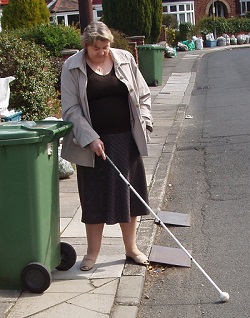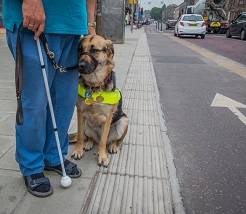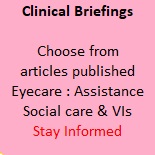Charities & Support Groups
Royal National Institute of Blind People Scotland
Royal National Institute of Blind People Scotland
A national sight loss charity has told a Scottish Parliament committee that accessible streets and thoroughfares are key to persuading blind and partially sighted people back to shops.
 RNIB Scotland has responded today [Thursday, April 14th] to a call from the Parliament’s Employment and Fair Work Committee for views on ‘the new realities of retail and e-commerce’.
RNIB Scotland has responded today [Thursday, April 14th] to a call from the Parliament’s Employment and Fair Work Committee for views on ‘the new realities of retail and e-commerce’.
Recent figures from the Scottish Retail Consortium have showed footfall in shops had dropped by 21.1 per cent in March compared with pre-pandemic figures for 2019, worse than an average UK decline of 15.4 per cent and the steepest for all four UK nations.
RNIB Scotland’s campaigns manager Dr Catriona Burness said: “Prior to the pandemic, the streetscape was already challenging for people with sight loss. Simply leaving home presents challenges when pavements or walkways are cluttered or obstructed.”
A UK-wide survey by RNIB in 2015 found that 95 per cent of blind and partially sighted people had collided with an obstacle in their local neighbourhood over a three-month period, and that nearly a third of those were injured.
Now, the charity warns, new obstacles on pavements and walkways – such as dockless hire vehicles and the spread of electrical vehicle charging-points – are adding to obstructions like advertising boards and pavement-parking.
In its response, and in its manifesto for the May 5th Scottish local authority elections, RNIB Scotland has called for a ban on ‘shared spaces’ where vehicles, cyclists and pedestrians all use the same levelled surface; for controlled road crossings with audible and tactile signals to indicate when it is safe to cross; and for kerbs to be at least 60mm high where road use changes.
 The charity has also been critical of the hasty introduction of new street designs and cycleways during the lockdown period, highlighting concerns such as pavement café sprawl, increased numbers of proposed floating bus-stops, alongside temporary cycleways and traffic-management bollards.
The charity has also been critical of the hasty introduction of new street designs and cycleways during the lockdown period, highlighting concerns such as pavement café sprawl, increased numbers of proposed floating bus-stops, alongside temporary cycleways and traffic-management bollards.
“We have expressed concern that the new street layout arrangements might effectively extend lockdown for blind and partially sighted people,” said Dr Burness. “Feedback from our members has confirmed that many have found the new arrangements worrisome and challenging. Sixty-six per cent of people we asked in 2020 said they now feel less independent than they did before the covid pandemic.
“Being able to walk safely and confidently is of fundamental importance in ensuring blind and partially sighted people can live their lives as independently as possible. However, recent changes to the layouts of our towns and cities have impacted on their safety and confidence in going outdoors.”
The charity points to other studies that it says corroborate this. A recently published Public Health Scotland report, ‘Road Space Reallocation in Scotland: A Health Impact Assessment’, acknowledges that with most reporting that the measures made it more difficult for them to get around’.
Images Picture Copyright Chris Watt
























